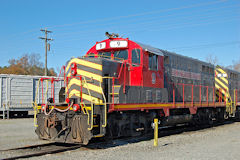by James A. Bacon
Pity Virginia’s short-line railroads. There are nine of them, they serve 150 industrial customers and they operate 500 miles of track, hauling products from peanuts and lumber to stone and steel. But they are no match for the big hogs on the farm when it comes to grubbing for state and federal money.
Most of the state’s short lines came into existence when Virginia’s dominant railroads, Norfolk Southern and CSX Corp., decided to cut unprofitable rail lines. Rather than leave industrial customers twisting in the wind, the big railroads agreed to sell or lease the lines to independent companies that could operate them at lower cost.
Whit Clement, secretary of transportation under the Warner administration, made the case Wednesday to the Commonwealth Transportation Board that the short lines merited greater state government support. The short lines provide an alternative to heavy trucks, he said, and by taking trucks off the road, they reduce wear and tear on state highways, lessen dependency on foreign oil and cut the emission of pollutants. A truck emits more than three times as much nitrogen oxide per ton-mile as a locomotive, he said.
The short lines traditionally have accessed a number of state funding programs, including a $23 million-a-year rail enhancement fund, a $10 million rail preservation fund, a $3 million rail industrial access fund and an intercity passenger and rail operating capital fund. The problem, said Clement, is that the funds available to freight railroads have stayed the same or even declined as the state has shifted resources from freight to passenger rail projects. “There is strong competition for the rail enhancement money.”
Failure to maintain funding for freight rail will result in more heavy trucks on the road, Clement told the CTB. One heavy truck, he added, has the same impact on roadway maintenance as 90 automobiles.
In response to CTB rural representative Allen Louderback, Clement conceded that the lack of funding was not at present halting any specific project from moving forward. But he did say “there could be some great opportunities in the future” that could get stalled.
It is an article of faith in Virginia’s railroad industry that trucks don’t pay their fair share of motor fuel taxes to cover the cost of maintaining state roads. The under-tax amounts to a subsidy for trucks. By contrast, railroads must pay the full cost of their own maintenance. Rather than seek government grants, why not push the General Assembly to raise the motor fuels tax on trucks?
That option, said Clement, “is not on the table.” The trucking lobby is just too powerful. The freight railroads believe they stand a better chance clawing back funds from the passenger rail lobby.




